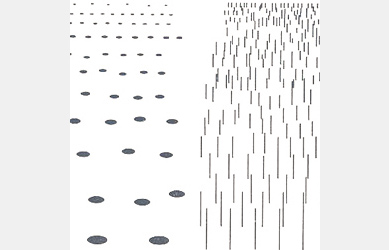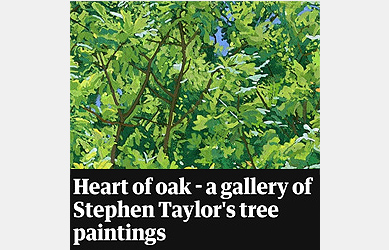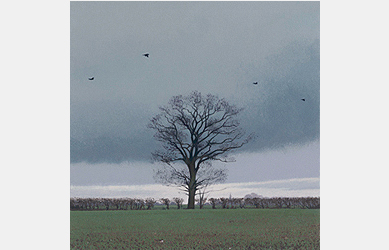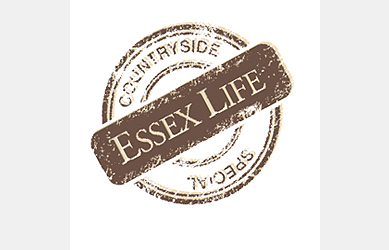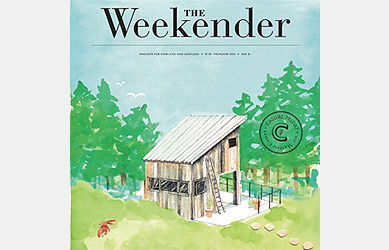I do most of my birdwatching at work.As a landscape painter, I can t really avoid it. My last two shows were based on a single field in north Essex. This field is farmed like a factory: barley, rape, wheat, year on year, so my on-the-job birdwatching is modest, and I can confirm that fields like this don t support a wealth of birdlife. Yet there are birds about, and when I see them I’m usually mixing oil paint, trying to paint the place they live in, and I sometimes paint them in too.
My starting point as a painter is that I don t know what’s there until I’ve looked. This goes for everything: colour, shape, texture, scale. But because my paintings are built up from distinct mixes of colour, the most important of these is colour.
Every last bit of the landscape has to be converted into a mix of some sort. So, if a bird flies past and I want to include it, the first thing I do is identify and mix its colour. If you know your birds, you might think this should be easy enough. Blackbirds are black, greenfinches green, and blue tits are blue and yellow with bits of black and white.
Well, actually, no. A blue tit can look grey, cream, green or black, or be just plain invisible. Blackbirds can be violet-grey; greenfinches almost orange. It’s a point most painters understand, but do all birdwatchers? And, if you’re not sure about it, is it possible you’re missing other things about colour in nature?
I think we have to look because there really is nothing quite like experience. As a painter, I’m partisan. I think painting can help us notice things in a unique way, that can help us see birds, you might say, in a different light.
Landscape painting is a way of representing a visual environment. If I see a bird, I’m very aware that its colour exists inside the colours of the environment around it. This might sound an odd way to put it, but consider how colours in a painting are accumulated.
A colour in a painting is like a note on a stave. It has no ‘value’ except in relation to the other notes. Its character and expression come by comparison with all the notes around it. Painters sometimes talk about trying to paint ‘in key’, so the black of a blackbird on a branch in daylight might have to be compared with the colour of oak bark in shadow directly behind it. This could mean comparing a violet-grey (the bird) with a black-brown (the bark). Assess these colours one against the other, mix them, and they will both be in key.
They will look right partly because you have taken into account what are called effects of simultaneous contrast. The darker tone will have made the lighter tone look lighter, and the warmer colour made the cool colour look cooler. By capturing this, you’ll correctly paint a violet blackbird—and it will look just right, unlike a black blackbird.
So, a bird in a landscape is like a note in a piece of music. The same bird flying through a different landscape will be part of a different piece of visual music. Its colour will be different, and if you’re trying to paint it you’ll have to mix a new colour by comparing it with other new colours. Not surprisingly, observational painting can make you think aboutwhy colour perception is so unstable. And it certainly makes you take with a pinch of salt the idea that a blackbird is always, at all times, black!
Another reason why colour shifts is that illumination changes. And there’s much more to illumination than just the brightness of things in or out of the sun. Different kinds of illumination fall on objects: there are many kinds of direct light and an incredibly rich array of reflected lights from every direction,
each with its own distinctive colour. Outdoors, there is direct moonlight,reflected light from water and rock, transmitted light through leaves . . .
Each of these lights will change the appearance of object colours. For example, green light under trees makes green leaves look even greener but pink bark browner. Direct light passing between leaves introduces a yellower light, and there will be reflected lights everywhere. Inside an oak canopy, it’s
quite possible for the yellow on a blue tit to look green—so a predator with colour vision would have less chance of seeing it.
The colours we see on a bird, then, carry information about illumination. With practice, a painter can paint the colours of objects combined with the colour of the light falling upon them. By careful mixing you can build in common colour components of the illumination, so the painting will have something of the natural light you see. Painters that love the light of nature try to do this all the time. It’s a challenge. It’s a particular challenge because you can never predict what the combinations of colour and light in the natural world will actually look like.
But, you may be thinking, birdwatchers use images that predict bird colour all the time—after all, that’s what traditional field guides are, page after page of predictive pictures—”this is what they look like”. So it’s all very well for a landscape painter to go on about shifting keys and lights, but if bird colour in the landscape varies so much, how do field guide painters choose their colours? And why are painted field guides so useful?
Since the earliest illustrators, artists whose main interest was identification have tried to neutralise effects of illumination by concentrating on what are sometimes called ‘local’ colours. Perhaps the best way to do this is to work from a dead or stuffed bird in fairly neutral light, such as you get from daylight through a north facing window in a traditional studio. It can also be useful to have some kind of white sheet in view as a neutral reference. Colours for the different parts of the bird are then mixed by comparing each colour with other colours on the bird, without looking at anything in the immediate environment that could affect the perception, except perhaps the white.
In this way, it’s possible to paint groups of colours that will more or less describe the pigmentation of an individual bird. It is the way that Audubon worked, for example, after he had shot his specimens and taken them indoors.
Most field guide illustrators are interested in visual classification by order, family, genus and species. This means the colours of a bird on the painter’s table may have to be compared with the colours of a very similar bird, which at first glance looks identical. For example, is the brown on the back of a common sandpiper lighter or darker than the brown on the back of a spotted sandpiper? Do artists for such guides have a pile of sandpipers in all their plumages (eight) in the studio? Or all the British gulls? (Sixty-seven if you count summer, winter, adult and juvenile plumages.)
I asked some specialist bird artists about this. It turned out that, yes, many field guides have been made using the many “skins”—bird skins mounted on a stick and stretched out—that are available. The national collection is held at Tring, and there, professional illustrators can compare and paint sandpipers and gulls in a way that will minimise effects of context and lighting—taking out the coloured illumination, contrast effects and light and shade of the real world outside. The birdwatcher using such a guide has a basic “colour chart” for his birds, but should be aware that they will be subject to continually varying effects.
It’s worth realising just how carefully each bird has to be compared with the next. Alan Harris, responsible for many excellent pages in my own more traditional field guide, gave me an idea of this when told me of a “plate of sparrows”. He had made painted notes for the page from skins in a museum,
but when he came to use the notes in the studio he made the first bird slightly too dark. Correctly comparing one sparrow with the next, by the time he got to the darkest one it was so dark it looked like a different species. He had to change them all.
This kind of attention is necessary to distinguish different species, and I love the kind of illustration it produces. What strikes me about the colour is its lack of daylight and its slightly “fixed” look. But I don’t think this is a bad thing.
Quite the opposite. The birds look like what they are intended to be: sets of attractive coloured shapes to be read relative to one another in an ideal world of pages: family, genus, species. What’s more, in spite of their contrivance, I usually find the colours perfectly useful.
As readers of Birds will know, identification is rarely made by colour alone. Shape, flight, call, behaviour and location all play a part; and the more experience you have the more these begin to work together. Because nature’s colour changes all the time, we can’t expect exact matches between the colour on the page and the bird in the field. For identification, colours in a field guide are just another clue. And because the artist has skilfully removed illumination and contrast effects, and set them out in ranks on a plain page, these birds don’t claim to look particularly real. This lets in other things.
You see small changes as part of a taxonomic scheme, so you see a big idea alongside the individual. And there’s an important other side to this. Because these little pictures don’t try to look like experiences, you could say that they leave you exposed to experience. They don’t confuse the issue.They complement your thoughts about looking; they don’t claim to look for you.
Of course there’s plenty of room for other kinds of bird illustration, and very useful too. Photography, in particular, plays a major role in modern field guides. Photographs are now probably the commonest form of imagery on the planet. So how useful is photographic colour in a field guide?
In everyday English “photographic” still suggests “accuracy”. But accurate colour may not identify a bird. The colours captured by modern digital cameras can be very accurate indeed, but they will show just how variable colours in the outdoors are. It can be impossible to make a positive identification from a single photograph, which is why guide books often show several images of the same species in different conditions. Some websites show many shots of a single bird for the same reason. Which brings us back to violet blackbirds and orange greenfinches. Photographs incorporate the illumination effects that traditional illustrators seek to eliminate. They also show contrast effects with the environment: a reed warbler against green reeds will look reddish and in evening light, redder still.
The field guide designer has to find typical images, which can be very difficult with a camera. Wildlife artist Robert Gillmor put it to me this way. “The photographer’s bird is an individual. It might be seedy that day. It might be being blown about. It could be between plumages, or making odd movements; and as for the lighting! Two photographers photographing the same bird in the same minute will produce two different coloured birds.”
Photographs are clearly a wonderful way to show new aspects of birdlife. But I think they should come with a health warning: “to be taken in moderation.” For identification, the more individually perfect the photograph, the less it will look like the particular bird you are looking at: the photographer’s bird is an individual, as is yours.
And all this super real digital impact is seductive… It can tease us into feeling the image is something it can never be—a real experience: which is probably the source of the oddity that I find with bird guide photography. Those little ersatz patches of reality are so very unlike the all-surrounding, shifting, visually messy experience of nature. And I personally think they can get in the way.
Don’t get me wrong. Used well, photography can reveal things. It can open eyes and minds. Photography can be both useful information and excellent art. But it’s precisely because digital imagery is now so good that the production values can mislead. No, it’s not a bird, it’s pixels. It’s a mechanical reproduction. The experience of nature cannot be confined to screen or print.
Birdwatchers and landscape painters spend a lot of time outdoors, and experience helps. Over the past few years, I’ve met some expert birdwatchers, including a few serious twitchers, and in spite of awesome optics, pagers and almost publishable notebooks, I’ve still not met the caricature tick-list anorak. As a painter, what strikes me about expert birders is not so much the checklists as their openness to the natural world—especially their sense of how everything they see is somehow provisional.
Identification can be a delicate business. Which way is the wind blowing? What are the odds in this sort of ground cover? Maybe it’s a late moult? Would you see two together? Is that a blue-green or a blue-grey? The idea that nature is changeable and unpredictable is built in to the way expert birdwatchers see. It could be this, it could be that. And sometimes you just can’t tell at all. Acquired knowledge of appearance and behaviour, of predictability, is used outdoors to interpret the unpredictable. And the sheer trickiness of seeing nature is surely part of the fascination.
Landscape painting teaches you that nature is elusive. Possibly only painters know just how much acquired knowledge and technique goes into making a picture out of a few moments of experience. And in my view, the best observational painting gives us a sense of having caught something - on the wing.
To do this you have to have a sense of the painting being made, to be reminded that the paint on the surface, though finished, emerged, and that the scene, though captured, will change. This is part of the fascination of painting, and perhaps it’s what draws me to add birds to my own pictures. Seen within a landscape, the shifting colours and shapes of birds seem to me a perfect metaphor for movement, beauty - and not presuming to know.
